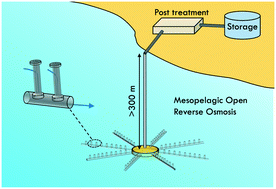Emerging investigator series: toward the ultimate limit of seawater desalination with mesopelagic open reverse osmosis†
Abstract
Seawater desalination has become an important tool to attain global water security and sustainability. Among the available technologies, reverse osmosis (RO) has become the golden standard for seawater desalination due to its unparalleled energy efficiency. While RO is already efficient after development for half a century, there remains room for over 50% further reduction in energy consumption that can translate into tens of terawatt hours of potential annual energy saving. However, this significant energy saving cannot be achieved under the conventional paradigm of on-ground RO. In this analysis, we assess the idea of operating RO with open modules several hundred meters below the ocean surface (i.e., the mesopelagic zone). This new process, namely mesopelagic open reverse osmosis (MORO), can potentially push the energy consumption of seawater desalination to its theoretical limit. We first describe the concept of MORO, and then examine both the theoretical potential of energy saving and the practical challenges facing the implementation of MORO. Our analysis provides a theoretical framework for the future development of MORO for more sustainable desalination.

- This article is part of the themed collection: Emerging Investigator Series


 Please wait while we load your content...
Please wait while we load your content...